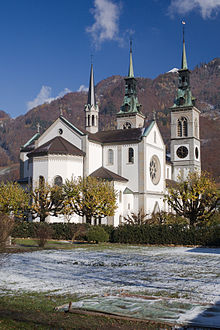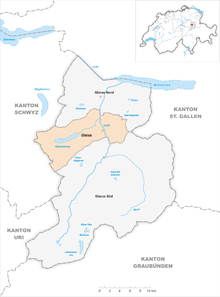- Glarus
-
Glarus Country Switzerland 
Canton Glarus District n.a. 47°02′N 9°04′E / 47.033°N 9.067°ECoordinates: 47°02′N 9°04′E / 47.033°N 9.067°E Population 12,166 (Dec 2009)[1] - Density 117 /km2 (304 /sq mi) Area 103.7 km2 (40.0 sq mi)[2] Elevation 472 m (1,549 ft) Postal code 8750, 8754, 8755 SFOS number 1632 Surrounded by Glarus Nord, Glarus Süd, Innerthal (SZ), Muotathal (SZ) Twin towns New Glarus (USA), Kobryn (Belarus), Rožňava (Slovakia), Wiesbaden-Biebrich (Germany) Website www.gemeinde.glarus.ch
SFSO statisticsGlarus (German: [ˈɡlaːrʊs] (
 listen); French: Glaris; Italian: Glarona; Romansh: Glaruna) is the capital of the Canton of Glarus in Switzerland. Glarus municipality since 1 January 2011 incorporates the former municipalities of Ennenda, Netstal and Riedern.[3]
listen); French: Glaris; Italian: Glarona; Romansh: Glaruna) is the capital of the Canton of Glarus in Switzerland. Glarus municipality since 1 January 2011 incorporates the former municipalities of Ennenda, Netstal and Riedern.[3]Glarus lies on the Linth River at the foot of the Glärnisch foothills in the Glarus Alps. The municipality has about 5800 inhabitants. Very few buildings built before the fire of 1861 remain. Wood, textile, and plastics, as well as printing, are the dominant industries. The symbol of the city is the neo-romanesque city church.
Contents
History
Glarus is first mentioned in the early 9th Century in Latin as Clarona. In 1178 it was first mentioned in German as Glarus.[4]
On 10 February 878, the Emperor Charles the Fat gave his wife Richgard or Richardis the monasteries of Säckingen, of St. Felix and of Regula in Zurich as a royal estate. This land grant included extensive political rights and a large estate. This estate covered land in the Rhine and Frick valleys, the southern Hotzenwald, land in Zurich, along Lake Walen and the valley of Glarus. Glarus remained under the authority of the Abbey until 1395, when the Glarus valley broke away from the Abbey and became independent.[5]
It became the capital of the Linth valley in 1419. In the 18th and 19th centuries, the valley began to be industrialized.
Huldrych Zwingli a leader of the Reformation in Switzerland served in his first, Roman Catholic, ecclesiastical post in Glarus, starting around 1506. He served there for ten years. It was in Glarus, whose soldiers were used as mercenaries in Europe, that Zwingli became involved in politics. The Swiss Confederation was embroiled in various campaigns with its neighbours: the French, the Habsburgs, and the Papal States. Zwingli placed himself solidly on the side of the Roman See. In return, Pope Julius II honoured Zwingli by providing him with an annual pension. He took the role of chaplain in several campaigns in Italy, including the Battle of Novara in 1513. However, the decisive defeat of the Swiss in the Battle of Marignano caused a shift in mood in Glarus in favour of the French rather than the pope. Zwingli, the papal partisan, found himself in a difficult position and he decided to retreat to Einsiedeln in the canton of Schwyz. While he was not a reformer at Glarus, there he began to develop the ideas that would lead to the break with the Catholic Church in Zurich
In 1528 the Reformation gained a foothold in Glarus, directed by Zwingli in Zürich. Even though he had preached in Glarus for 10 years, the town remained strongly Catholic. However, following the Second war of Kappel in 1531 both the Catholic and Protestant residents were given the right to worship in town. This led to both religious groups using the town church simultaneously, an arrangement that caused numerous problems. By the 18th Century both the groups shared the church but had separate organs. In 1697 there were two financially and theologically independent parishes meeting in the city church.[6]
Following the French invasion in 1798, Glarus became the capital of the Canton of Linth in the Helvetic Republic. The administration of the Canton moved into Glarus. However, the new administrators had difficulties in establishing and enforcing any new regulations. In August 1802 the administrators of the new Canton left Glarus for Rapperswil due to the difficulties they had faced in Glarus. In 1803, with the Act of Mediation, the Canton of Linth was dissolved and Glarus became the capital of the smaller Canton of Glarus.[7]
Glarus now contains but few houses built before 1861, for on the 10/11 May 1861 practically the whole town was destroyed by fire that was fanned by a violent Föhn or south wind, rushing down from the high mountains through the natural funnel formed by the Linth valley. The total loss is estimated at about half a million sterling, of which about £100,000 were made up by subscriptions that poured in from every side.[8] About two thirds of Glarus (593 buildings) were destroyed in the big fire. After this incident, Glarus was rebuilt in block fashion according to construction plans by Bernhard Simon and Johann Caspar Wolff.
In 1864, the first European labor law to protect workers was introduced in Glarus, prohibiting requiring workers to work more than 12 hours a day.
Geography
The town is located in the Glarner Mittelland on a broad valley floor between the Glärnisch mountain and the Linth river.
Glarus municipality before 2011 had an area of 69.2 km2 (26.7 sq mi). Of this area, 23% was used for agricultural purposes, while 31.4% was forested; of the rest of the land, 2.7% was settled (buildings or roads) and the remainder (42.9%) was non-productive (2006 figures).[9]
With the incorporation of Ennenda, Netstal and Riedern in 2011, Glarus municipality now has an area of 103.6 km2 (40.0 sq mi).
Demographics
Glarus had a population (as of 31 December 2009) of 12,166, including Ennenda, Netstal and Riedern.[1] As of 2007[update], 23.7% of the population was made up of foreign nationals.[10]
Over the last 10 years the population has grown at a rate of 7.4%. Most of the population (as of 2000[update]) speaks German (86.0%), with Italian being second most common ( 4.8%) and Albanian being third ( 2.6%).[9]
In the 2007 federal election the most popular party was the SPS which received 68.9% of the vote. Most of the rest of the votes went to the SVP with 23% of the vote.[9]
The entire Swiss population is generally well educated. In Glarus about 71.3% of the population (between age 25-64) have completed either non-mandatory upper secondary education or additional higher education (either university or a Fachhochschule).[9]
Glarus has an unemployment rate of 2.01%. As of 2005[update], there were 49 people employed in the primary economic sector and about 17 businesses involved in this sector. 552 people are employed in the secondary sector and there are 78 businesses in this sector. 3,232 people are employed in the tertiary sector, with 410 businesses in this sector.[9]
The historical population is given in the following table:[4]
year population Swiss Citizens % German Speaking % Protestant % Roman Catholic 1554 ca. 1,550 1682 ca. 1,200 1777 ca. 2,400 1837 4,094 1850 4,082 3,960 86.0% 14.0% 1870 5,485 5,204 77.7% 22.6% 1888 5,357 4,968 98.1% 71.6% 28.0% 1900 4,877 4,424 97.5% 74.2% 25.6% 1910 5,123 4,471 94.8% 70.8% 28.7% 1930 5,269 4,858 97.7% 70.5% 29.2% 1950 5,724 5,376 96.2% 68.0% 31.4% 1970 6,189 5,215 86.9% 60.5% 38.9% 1990 5,728 4,723 86.1% 51.9% 42.4% 2000 5,556 4,379 86.0% 45.4% 37.7% Weather
Glarus has an average of 148.2 days of rain per year and on average receives 1,416 mm (55.7 in) of precipitation. The wettest month is August during which time Glarus receives an average of 177 mm (7.0 in) of precipitation. During this month there is precipitation for an average of 14.7 days. The month with the most days of precipitation is June, with an average of 15.1, but with only 164 mm (6.5 in) of precipitation. The driest month of the year is January with an average of 86 mm (3.4 in) of precipitation over 14.7 days.[11]
Climate data for Glarus Month Jan Feb Mar Apr May Jun Jul Aug Sep Oct Nov Dec Year Average high °C (°F) 2
(36)3.7
(38.7)7.9
(46.2)12.6
(54.7)17.4
(63.3)20.2
(68.4)22.2
(72.0)21.2
(70.2)18.3
(64.9)13.7
(56.7)7.4
(45.3)3.1
(37.6)12.5 Daily mean °C (°F) −1.2
(29.8)0.3
(32.5)3.6
(38.5)7.7
(45.9)12
(54)14.9
(58.8)16.9
(62.4)16.2
(61.2)13.4
(56.1)9.1
(48.4)3.7
(38.7)−0.3
(31.5)8 Average low °C (°F) −4
(25)−2.7
(27.1)−0.1
(31.8)3.2
(37.8)7
(45)10
(50)12.1
(53.8)11.8
(53.2)9.3
(48.7)5.3
(41.5)0.5
(32.9)−3.3
(26.1)4.1 Precipitation mm (inches) 86
(3.39)87
(3.43)91
(3.58)104
(4.09)127
(5)164
(6.46)175
(6.89)177
(6.97)112
(4.41)89
(3.5)101
(3.98)102
(4.02)1,416
(55.75)Avg. precipitation days 11.7 10.3 12.3 13 14.5 15.1 15.1 14.7 10.9 8.9 10.9 10.8 148.2 Source: MeteoSchweiz [11] Gallery
International relations
Main article: List of twin towns and sister cities in SwitzerlandTwin towns — Sister cities
Glarus is twinned with:
External links
- Official Web site (German)
- Glarus (municipality) in German, French and Italian in the online Historical Dictionary of Switzerland.
References
- ^ a b Swiss Federal Statistical Office (German) accessed 4 April 2011. Numbers are from December 2009 but cover the new municipal borders from 2011.
- ^ Arealstatistik Standard - Gemeindedaten nach 4 Hauptbereichen
- ^ Amtliches Gemeindeverzeichnis der Schweiz published by the Swiss Federal Statistical Office (German) accessed 18 February 2011
- ^ a b Glarus in German, French and Italian in the online Historical Dictionary of Switzerland.
- ^ Säckingen in German, French and Italian in the online Historical Dictionary of Switzerland.
- ^ Glarus from the High Middle Ages until the 18th Century-Churches in German, French and Italian in the online Historical Dictionary of Switzerland.
- ^ Glarus in the 19. and 20. Centuries-Political and administrative development in German, French and Italian in the online Historical Dictionary of Switzerland.
- ^
 Chisholm, Hugh, ed (1911). "Glarus (capital)". Encyclopædia Britannica (11th ed.). Cambridge University Press.
Chisholm, Hugh, ed (1911). "Glarus (capital)". Encyclopædia Britannica (11th ed.). Cambridge University Press. - ^ a b c d e Swiss Federal Statistical Office accessed 10-Sep-2009
- ^ Canton Glarus population growth (German) accessed 9 September 2009
- ^ a b "Temperature and Precipitation Average Values-Table, 1961-1990" (in German, French, Italian). Federal Office of Meteorology and Climatology - MeteoSwiss. http://www.meteoswiss.admin.ch/web/de/klima/klima_schweiz/tabellen.html. Retrieved 8 May 2009., the weather station elevation is 516 meters above sea level.
Municipalities from January 1, 2011 Glarus Nord | Glarus | Glarus Süd

Former municipalities Capitals of Swiss cantons Categories:- Municipalities of Glarus
- Municipalities of Switzerland
- Canton of Glarus
- Cantonal capitals of Switzerland
- Cities in Switzerland
Wikimedia Foundation. 2010.















